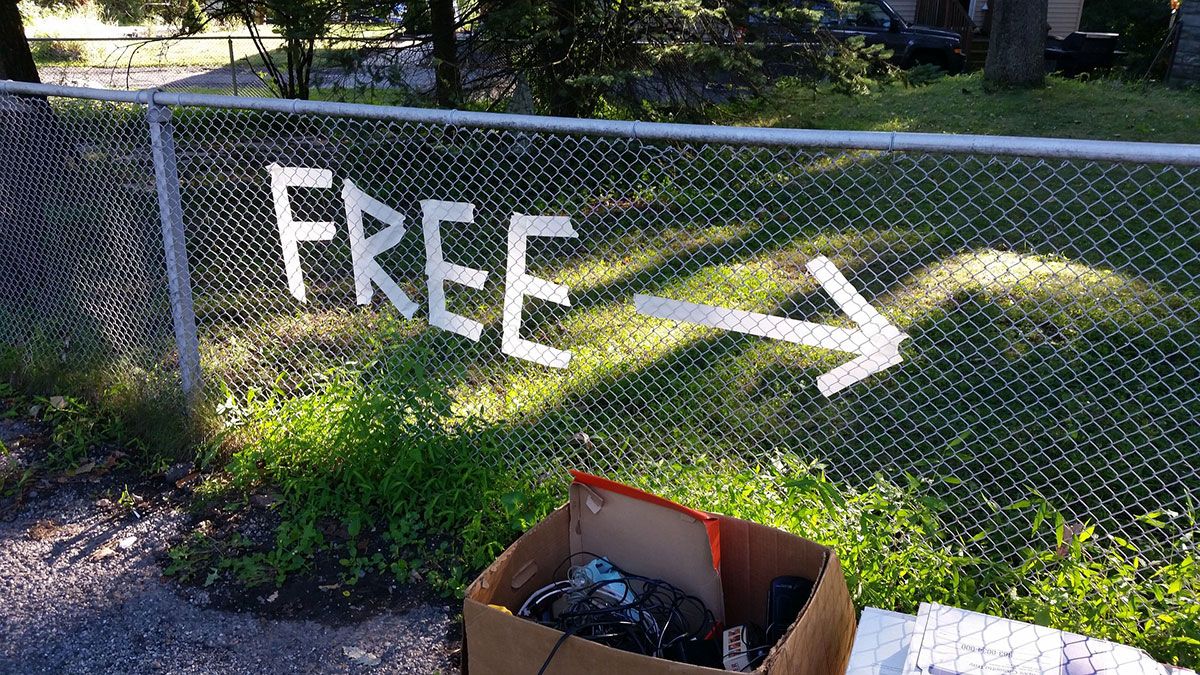How To Downsize Your Home

The desire to simplify and downsize your home is one thing – but knowing how to downsize your home successfully is a different story.
Some homeowners choose to downsize to lead a more minimalistic lifestyle, while others simply want a smaller house as they head into retirement or send their grown kids to live life on their own. Whatever your reason for downsizing, planning the process ahead of time can help you get the results you want.
How To Downsize Your Home
- Take Inventory of Current Belongings vs. Size of New Home
- Sell or Donate What You Don’t Use Anymore
- Rent a Dumpster for Items You Can’t Donate
- Start Giving Away Sentimental Items to Family
- Digitize What You Can
- Stop Buying New Items
- Plan Your New Layout
If there are still little feet running around the home, it may not be the best time to make the switch to downsizing. However, many homeowners know when they and their family are ready for a smaller, less cluttered space. And, they probably want to know how to move from a larger home to a smaller house without sacrificing the space each loved one needs or special items they don’t want to give up.
You can take several steps to prepare your current home for downsizing, such as mindfully taking stock of sentimental items and having everyone pitch in with decluttering. From hosting a yard sale to making the most of unused space in your new home, making the right moves can help your downsize be a success.
Why Downsize To a Smaller Home?

If downsizing your living space is something you haven’t yet considered, you might be wondering what is the purpose of a downsize. There are several reasons people have for downsizing their homes, including financial reasons and leading a simpler lifestyle.
Save Money
Perhaps the top reason you want to learn how to downsize your home is to save money. Homeowners participate in things like making a budget and learning how to spend less money and save for their futures. However, no matter how much they try to save, a hefty house bill can eat into those savings quickly.
When you downsize, you get a smaller home. Usually, that means less money to spend on the new home to buy it, furnish it, and maintain it. After transitioning to a smaller space, you’ll probably notice a lighter load on your finances, especially your mortgage payment. You’ll likely even have a lower down payment and reduced closing costs if you specifically shopped around for a more affordable new place.
Budget for Retirement
A home that’s larger than you need can eat into your retirement budget over time by preventing you from having extra money to fund your account. Smaller homes require less money to maintain, and you won’t have to buy as many items to fill them. The money you save on your mortgage, repair costs, cleaning costs, and other housing-related expenses could go directly into your retirement fund instead.
Kids Have Moved Out

At some point, your kids will likely move out of the family home to pursue their goals and start a life of their own. If that time is now, it may be the perfect time to learn how to downsize your home. Having a little bit of extra space can be helpful when they come back for a visit. But it’s likely that the home you needed while the kids were growing is too big for just you or you and a partner.
Simplify Lifestyle
Some homeowners choose to downsize their homes when they’ve decided that their current lifestyle is no longer serving them well. For example, a decade ago, you might have preferred more space and high-end finishings in your home. However, moving into your 30s, 40s, and beyond, simplicity and minimalism might appeal to you more. Downsizing a home is an ideal way to achieve simplicity in your life.
Less Maintenance
Think about the differences between a large home and a smaller home in terms of cleaning, repairing, and maintaining them. The more square footage you have, the more money and time you’ll need to spend maintaining your home. That’s why plenty of homeowners choose to downsize their homes solely because they’ve come to prioritize reduced maintenance time and costs.
Minimize Clutter

A spacious home leaves more room for clutter than a downsized home. Even if the larger space has more storage space available, that leaves extra footage for clutter to gather in cabinets, drawers, and closets. Most of the time, that clutter is unnecessary items that just take up space in your home.
With a smaller, downsized space, you might have less storage area, but the reduced space can be a helpful reminder to rid your home of unnecessary items before they become clutter. As a result, you get a cleaner, more welcoming space filled with only the things you need.
How to Downsize Your Home
Not sure where to start when learning how to downsize your home? Follow these steps as you remove clutter, get rid of things you don’t need, and work through the downsizing process.
1. Take Inventory of Current Belongings vs. Size of New Home
The square footage of your new home can help you prepare to furnish your new space. Compare the square footage of the smaller property with that of your current property. For example, if your current place is 2,000 square feet, but your new place is 1,000 square feet, you’re losing half of your space and will need to adjust what you’re bringing with you accordingly.
It can be difficult deciding what to keep and what to do away with when downsizing. A good place to start is to downsize each room by the difference between your current and new spaces. Using the example above, you’d aim to get rid of half of your belongings in each room, if possible.
2. Sell or Donate What You Don’t Use Anymore

Another way to ensure that you’re not bringing extra belongings with you that you don’t need is to consider what you actually use and what you haven’t used in a while. Think back about six months. Have you used items sitting in a closet in that length of time? How about cookware in the back of a cabinet? Unused toys, clothing, and books are also space-takers that you may be able to discard.
Then, find places to sell or donate items you don’t need. Facebook Marketplace can be helpful for quick sales or giving away free items. Or, host a garage sale to make some extra cash and get rid of excess belongings. You can also see if a Salvation Army, Goodwill, or another similar donation place is open to donations of specific items.
3. Rent a Dumpster for Items You Can’t Donate
Some items may not be able to be donated, depending on what your local donation centers need. You might also not be able to sell other items, like worn-out furniture or toys. A rentable dumpster can come in handy for the belongings you don’t have a spot for, especially large furniture pieces, like beds, mattresses, and tables.
Call your disposal company first, as they may have a deal on rentable dumpsters for current customers. Rentals are usually charged per week, but some companies may have per-day pricing. Depending on the size of the dumpster, expect to pay between $200-$500 per rental week. Enlist the help of friends and family to help you get rid of items to shorten the time you need to rent the dumpster.
4. Start Giving Away Sentimental Items to Family
Sentimental items can be the most difficult to purge because of all the memories they hold. Don’t feel like you need to get rid of family photographs, school papers, artwork, and hand-me-downs to successfully fit into your new space, though. Instead, think about family members or friends that you can pass sentimental items to. The items won’t be in your possession, but you can still be close to them when they’re in trusted hands.
Consider sending a group text to family or reaching out to friends to ask if they’d like to have specific items and start passing them out during the downsizing process.
5. Digitize What You Can

If you have a box – or several boxes – of paperwork scattered around your home or in storage, you’re not alone. While some documents do need to be saved, others may have been ready for the trash years ago. However, if you want to hold onto your papers just to be on the safe side, there’s another, more modern option than box storage: digitization.
Digital services make it easy to scan documents and store them in the cloud for easy access whenever you need them. For example, Dropbox has a scanning feature on its mobile app that lets you snap a picture of a document to scan and store it in your Dropbox files. Taking some time to do this before your move ensures that you won’t have to take all those boxes with you.
6. Stop Buying New Items
Although you might have the urge to buy new things to furnish your next space, doing so will counteract the work you put in to downsize. Think about how you might repurpose what you have to fit your new space. If it helps, try a No Spend Challenge the month before your move to avoid spending money on furniture or things that could cause more clutter.
7. Plan Your New Layout
You’re almost there! The last step is planning how you’d like your smaller house to look and finding smart ways to place items to maximize your space. Start by measuring the open areas you’ll have at the new place and determining where the furniture and belongings you’re taking with you can fit. Then, get inspiration from Pinterest, Instagram, and interior decorating blogs for minimalist tips that can help you design your smaller home.
In some cases, buying space-saving furniture, like a daybed with several drawers underneath, can be a good investment, especially if you’re replacing other furniture that won’t offer as much functionality.
How To Downsize Your Home
Moving into a smaller house can be scary if you’re making a big jump from having extra space in your home. However, downsizing can be a good savings move, allowing you to spend less money on housing costs and stash more away for retirement, emergencies, or general savings.
Treat the downsizing process methodically. Move through your home, consider what’s necessary for you and your family, and find ways to downsize by minimizing clutter, donating belongings you no longer need, and giving sentimental items to family members or friends. Soon, you’ll be on your way to enjoying your new, smaller space.